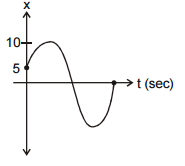| 1. |  |
2. |  |
| 3. |  |
4. |  |
For a particle executing SHM the displacement \(x \) is given by, \(A\cos \omega t.\) Identify the graph which represents the variation of potential energy (P.E.) as a function of time \(t\) and displacement \(x.\)
1. I, III
2. II, IV
3. II, III
4. I, IV

1. \(25~\text{Hz}\)
2. \(50~\text{Hz}\)
3. \(12.25~\text{Hz}\)
4. \(33.3~\text{Hz}\)

1. \(x= 10\sin\left(\pi t+\frac{\pi}{6}\right)\)
2. \(x= 10\sin\left(\pi t\right)\)
3. \(x= 10\cos\left(\pi t\right)\)
4. \(x= 5\sin\left(\pi t+\frac{\pi}{6}\right)\)
The figure depicts four \(({x\text-t})\) plots for the linear motion of a particle.
| (a) |  |
| (b) |  |
| (c) |  |
| (d) |  |
Which of the following is true?
| 1. | (a) is periodic but (c) is not periodic |
| 2. | (b) is periodic but (d) is not periodic. |
| 3. | (b) and (d) are periodic. |
| 4. | only (c) is periodic. |
The (displacement-time) graph of a particle executing SHM is shown in the figure. Then:

| (a) | the force is zero at \(t=\dfrac{3T}{4}\) |
| (b) | the acceleration is maximum at \(t=\dfrac{4T}{4}\) |
| (c) | the velocity is maximum at \(t=\dfrac{T}{4}\) |
| (d) | the potential energy is equal to the kinetic energy of oscillation at \(t=\dfrac{T}{2}\) |
| 1. | (a), (b) and (d) only | 2. | (a), (b) and (c) only |
| 3. | (b), (c) and (d) only | 4. | (c) and (d) only |
A body is performing SHM, then its:
| (a) | average total energy per cycle is equal to its maximum kinetic energy. |
| (b) | average kinetic energy per cycle is equal to half of its maximum kinetic energy. |
| (c) | mean velocity for a complete cycle is equal to \(\dfrac{2}{\pi}\) times of its maximum velocity. |
| (d) | root mean square velocity is \(\dfrac{1}{\sqrt{2}}\) times of its maximum velocity. |
Choose the correct alternatives:
1. (a), (b), (d)
2. (a), (c)
3. (b), (d)
4. (b), (c), (d)
(\(\omega\) is any positive constant)
| (a) | \((\sin\omega t+ \cos \omega t)\) |
| (b) | \((\sin\omega t+ \cos 2\omega t+ \sin4\omega t)\) |
| (c) | \(e^{-\omega t}\) |
| (d) | \(\mathrm{log(\omega t)}\) |
| (e) | \(\sin^{2}\omega t\) |
Choose the correct option from the given ones:
| 1. | (a) only |
| 2. | (a), (b), and (d) only |
| 3. | (a), (b), and (e) only |
| 4. | All of these |
Which of the following statements is/are correct.
| a. | Motion of a kink in a longitudinal spring produced by displacing one end of the spring sideways is transverse and longitudinal, both. |
| b. | Waves produced in a cylinder containing a liquid by moving its piston back and forth is longitudinal. |
| c. | Waves produced by a motorboat sailing in water are transverse and longitudinal, both. |
| d. | Ultrasonic waves in air produced by a vibrating quartz crystal are longitudinal. |
1. (a), (b) and (d)
2. (b) and (d)
3. (a), (c) and (d)
4. All are correct
A particle of mass \(m\) executes SHM along a straight line with an amplitude \(A\) and frequency \(f.\)
| Assertion (A): | The kinetic energy of the particle undergoes oscillation with a frequency \(2f.\) |
| Reason (R): | Velocity of the particle, \(v = {\dfrac{dx}{dt}}\), its kinetic energy equals \({\dfrac 12}mv^2\) and the particle oscillates sinusoidally with a frequency \(f\). |
| 1. | Both (A) and (R) are True and (R) is the correct explanation of (A). |
| 2. | Both (A) and (R) are True but (R) is not the correct explanation of (A). |
| 3. | (A) is True but (R) is False. |
| 4. | (A) is False but (R) is True. |







